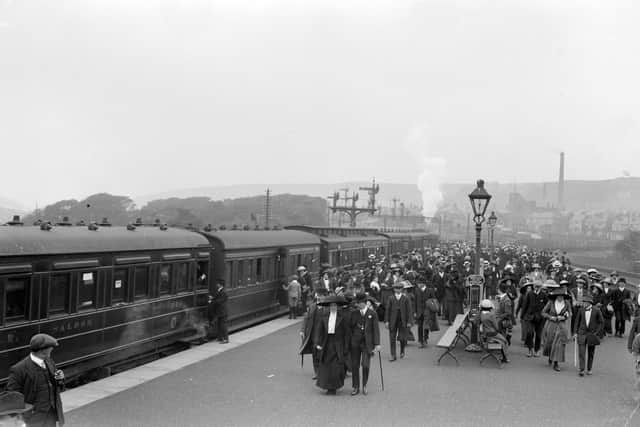Five of the oldest railway stations along the Yorkshire Coast and their history including Whitby and Scarborough
Yorkshire’s railway stations saw continued growth during the 1800s, with the population growing and the Industrial Revolution continuing significant industries such as coal, textile and steel.
Although the industry was flourishing, living conditions diminished in industrial towns due to overcrowding.
Advertisement
Hide AdAdvertisement
Hide AdBy the end of the century the industry saw improvements with advances such as the introduction of modern sewers and water supplies. Coastal town landmarks including railway stations which have a rich history.


Oldest railway stations along the Yorkshire Coast
Scarborough Railway Station
The Grade II listed railway station travels through the seaside town of Scarborough and is currently managed by TransPennine Express. It is also at the northern end of the Yorkshire Coast line and is thought to have the longest station seat in the world at 456ft.
The station was first established in July 1845, following the completion of the line from York. The first train, which included 35 coaches, was pulled by two locomotives named Hudson and Lion.
The original building was designed by G.T. Andrews and it had a wrought-iron and glazed roof. It was 106 metres long by 26.8 metres wide.
Advertisement
Hide AdAdvertisement
Hide AdThe main station building included a sizable central booking office, superintendent room, first class, second class and ladies’ waiting rooms, toilets, porters’ room, storeroom and refreshment room.
The heritage railway was considered an engineering marvel of its time.
It had a significant impact on the seaside town of Whitby and surrounding area’s development, providing a vital link for transporting items and people.
The opening of the turnpike to Pickering was in 1759 and Whitby depended more on the sea than land transportation as a result of the challenging climb over the high moors.
Advertisement
Hide AdAdvertisement
Hide AdOnce the turnpike was constructed, the journey remained difficult and it wasn’t until 1795 that stagecoach services started, and mail coaches started running three times a week in 1823.
Following the success of the Stockton and Darlington Railway, the concept of a railway from Whitby to either Stockton or Pickering was born. In 1832 George Stephenson was asked to report on the rival routes.
His report favoured a horse-worked railway to Pickering which was accepted at a meeting in Whitby on September 14, 1832. The Whitby and Pickering Railway bill received the royal assent from William IV on May 6, 1833.
Robin Hood’s Bay Railway Station
The now disused railway station used to travel on the Scarborough and Whitby Railway line and opened on July 16, 1885.
Advertisement
Hide AdAdvertisement
Hide AdIt served the fishing village of Robin Hood’s Bay, and occasionally the village of Fylingthorpe.
The goods yard had a crane and could withstand all kinds of weight with five sidings, cattle dock, coal yard, goods shed, and weighbridge and was the biggest intermediate station on the line.
Filey Holiday Camp Railway Station
The station officially opened on May 10, 1947 by Lord Middleton, Lord Lieutenant of the East Riding of Yorkshire.
It was located at the end of a short branch line off the Yorkshire Coast Line and had four terminus island platforms to cater for the large number of holiday makers arriving and departing from the holiday camp every Saturday during the holiday period.
Advertisement
Hide AdAdvertisement
Hide AdPassengers were taken to and from the station by a road train using this subway. The numbers of passengers dropped significantly as more people arrived at the camp by car.
The last train service departed on September 17, 1977, with formal closure taking place on November 26, 1977.
Staithes Railway Station
The line through Staithes had plans dating back to the late 1860s, however, the station did not open until December 1883 following a protracted building process which saw the viaducts on the line strengthened, financial ruin of the contractor and a diversion through the cliffs between Kettleness and Sandsend.
The station was host to a LNER camping coach from 1935 to 1939 and may have had a coach visiting in 1934 and 1935.
Comment Guidelines
National World encourages reader discussion on our stories. User feedback, insights and back-and-forth exchanges add a rich layer of context to reporting. Please review our Community Guidelines before commenting.
